Lots of people tell me it's their dream to have sheep one day. And the funny thing is, it was never something I hoped to do, until I was doing it. I’ve never been a real animal person; I love animals in a universal, do-no-harm kind of way, but in general, I've always preferred plants and babies to critters. I find caring for animals to be stressful because I’m never quite sure if they’re trying to tell me something important. Is it distress? Or simply gas? Or are they expressing affection?* And I was sure that my wimpy low tolerance for gore and muck disqualified me from farm life.
So how did I get into raising sheep? It was a neighbor, who keeps sheep for training her border collies, who made me think it would be possible for me. She confessed that putting in ear tags gave her the willies, and that she was terrified of mice. Well. I guess not all farmers have to be tough and imperturbable. But there was still the question of making such a big commitment. Sheep live for up to 12 years, and they need care, if not every day, most days. Also, I’m not a morning person, and so averse to early mornings that it was a serious argument for me to not have sheep. But my husband is a chirpy early bird, and the real animal lover in the family, so he agreed to take on the morning chores. With him willing do the morning chores, and even the evening chores when I wasn’t home, I couldn’t think of a reason why I shouldn’t get sheep.
I started researching by reading sheep books. I read and researched and read (and researched) until the new sources started repeating the old sources. I sought out other people who raise sheep, to get a first-hand account of the responsibilities and commitment involved. And this was tricky, because it’s hard to unearth sheep raisers. My local sheep breeders organization, the Garden State Sheep Breeders, was a terrific resource for finding some sheep people, but I knew there were a lot of people with sheep in my area who weren’t in any directory. It was low-tech, but I just asked everyone I knew if they knew people with sheep. I wanted to find people in my immediate area because I wanted to ask about vets, the soil, zoning requirements, and where to buy hay.
Everyone I talked to taught me something new, and everyone had their own opinion on just about every topic. Ask 2 sheep raisers a question, and you’ll get 5 different answers (and learn 3 new ways for sheep to die). Daily routines varied wildly from person to person. One person told me that all he did for his sheep was give them hay and water every other day, and that he spent more time and energy caring for his chickens than his sheep. But that same person also told me that he scooped all the sheep poop every day from his 2-acre field, so I can’t imagine what he did for his chickens. Someone else I know washes her sheep weekly, and blow dries them. It was a broad enough spectrum that I felt like I should be able to carve out a workable model for me and my sheep somewhere within that range.
Every breed has a national association, and their website lists registered breeders by state. Starting with Deb Robson’s The Fleece and Fiber Sourcebook, I made a short list of breeds I was interested in, and then looked for breeders in my area. Visiting with breed-specific sheep raisers was the most informative (and fun) part of research. Sure, sheep are sheep, but the three breeds I looked at: CVM, Babydoll Southdown, and Shetland, were distinct in their temperaments and care requirements. Many issues are specific to certain breeds, and in an emergency, I wanted to be able to call the breeder, not hunt for information online. The breeders I met with had knowledge that couldn’t be found in a book or a website, and they were familiar with their lines (i.e., each of their sheep’s lineage).

Visiting the sheep--especially at lambing time--is a joy, but poking around someone’s barn setup was just as fun. As someone who's always been ambivalent about houses, I was surprised to find myself fascinated by barn and gate setups. Some folks are handy with tools, and those were the farms where I really paid attention. I took pictures of particularly creative uses for cattle panels, baling twine, PVC pipes, and even repurposed furniture. There’s no real standard practice when it comes to housing a small flock of sheep. It seems to me that that small-scale sheep raising exists in a grey area, somewhere between commercial sheep ranching and keeping chickens in a backyard. Each person did things their way, and this was heartening, because if there’s one thing I can do, it’s do things my way.
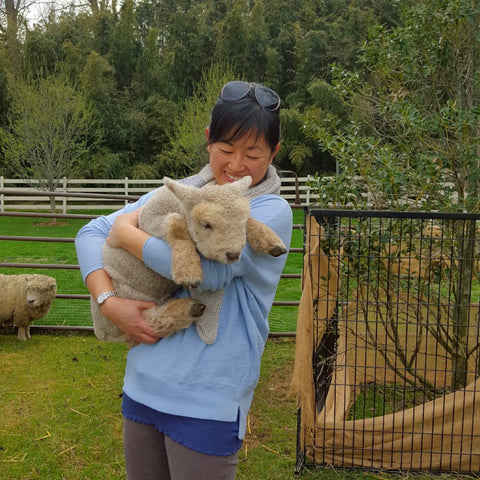
If you’re still interested in raising sheep after all your research, I’ll describe my setup, routine, and expenses.
Fencing: My fencing is woven wire, with metal posts, and wood posts at the gates. I don’t have electric fencing because I’m intimidated by them, and because they require maintenance (the hardware itself, and you have to keep the wires free of fleece). You also have to train your sheep to respect the fence. I have about half of my property fenced, divided into 3 fields. The fields are open and visible, but the next field I put in will be in the woods, so I probably should have electric fencing for that field. I’m happy with where the fences are, but one issue is that since all the gates are only 10’, I can’t have a large mower or dump truck come into the fields. I rotate my sheep between the two larger fields in the spring/summer/fall, and reserve the small front field as a sacrifice field in the winter. It gets mucky and eaten down to the ground, but they’re getting plenty of hay in the winter.
Shelter/storage: Sheep aren’t horses, who like to be bedded down nice and snug in their own stalls. My sheep don’t like to be inside at all, except when it’s pouring rain or snow, or when there’s no other shade. I think that my sheep would be happiest with lots of shade trees (preferably with branches low enough for them to eat the leaves), and a lean-to kind of shelter at the top of a hill where they could look out in all directions. But since I don’t have electric fencing, I wanted a secure place for them at night.
Where the 3 fields abut, I put in a 8’x12 run-in shed that’s open on one side. At the open side of the shed, there’s a 10’ x 12’ corral area, built with three 10’ gates, each one opening to a different field. That way, the corral and shed are accessible from whichever field the sheep are in at the moment. It’s where I gather them on shearing day, and it’s where I have them when the vet comes. This is also where I put them at night. My thinking is that even though the shed is open, the corral area is too small for a coyote or dog to be able jump into. Don’t quote me on this--it isn’t something I read anywhere or heard about; it's just my own rationale. In the picture below, I'd just shut them away for the night and all the gates are closed.
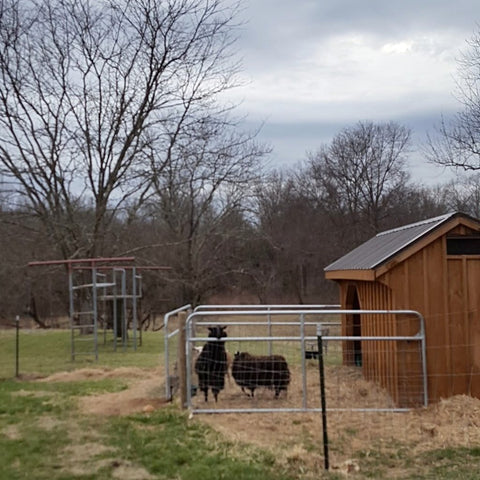
The location is perfect as a switching station between the fields, but I learned it was also a huge mistake because it’s at the bottom of a little hill. It flooded the first spring, turning the flooring inside the shed and the corral area into a mud pit. The wood of the shed even started to deteriorate, from sitting in mud. I put stall mats, which are thick plastic mats, in the floor of the shed, but I still haven’t figured out how to fix the mud pit in the corral. Someone recently suggested putting in a dump truck’s worth of stone dust. And once I figure out how to get a dump truck into the field (remember, my gates are too narrow), I’ll have to decide whether or not I want to spend that kind of money on the mud pit. The shed itself, I was able to have it raised and set on top of 8” x 8 ” railroad ties.
When I knew I wanted to breed, I bought a 12’ x 18’ barn with two sets of barn doors. One set of doors opens to a small fenced yard. The run-in shed is open, so I don't have to worry about ventilation. Because sheep sleep with their heads on the ground, it's important to have ventilation near the floor, so they're not breathing in harmful ammonia gas. I had the barn set on top of 8" x 8" railroad ties so that it wouldn't be sitting in the wet ground (lesson learned from the shed), and the gaps between the ties work as ground-level windows. I opted against stalls, because sheep are unhappy when they’re shut away alone. But when lambing, it’s best to have small, individual spaces for the mom and baby for the first few days. The small space makes it easier for the lambs to nurse, and for me to do checks on the mom and baby. One of my friends employs a farm manager who has decades of experience with sheep and has terrific carpentry skills. He designed modular stall panels for their farm, and I had him build panels for my barn. They partition the barn into 5 individual stalls, and a creep feeding area for lambs. I use one of the stalls for storing a few bales of hay, and other miscellaneous barn things like gear ties (for holding the panels together), extra feeders, and buckets.

A gate that swings open/closed is problematic because of hay buildup and the small space, so the top slats are removable, letting me climb over.** The creep feeder (pictured below) is particularly inventive, because the PVC pipes around the wood bars keep the too-big sheep from getting stuck. This is where I've been putting Roobie and her lambs at night lately, and you can see the dog gate that I use to cover the wide bars.

I have a large renovated barn that’s close to both the run-in shed and sheep barn. It has an attached storage area, and that’s where the bulk of my winter hay is stored. It’s not ideal because one side is clear plastic, and the sun bleaches the outside of the bales. But it keeps the hay dry and relatively free of mice.*** My dye studio is in the barn, and that’s where I store the grain and minerals. When I first got the sheep, I kept the grain in a stall in the run-in shed. But the sheep broke into the stall and ate all the grain. It could have been a tragic disaster, but I was really lucky that it was the bag that the breeder had sent with the sheep and there wasn’t very much in the bag. After that, I kept the grain in the greenhouse that’s attached to the barn. The grain got so hot it grew moldy, so now I keep it in the studio. It’s not the most convenient spot, but it works. All the extra buckets, feeders, scoops, etc., are piled into the greenhouse.
Neither the shed nor the barn have electricity, but the shed is close enough to the renovated barn to run an extension cord to the corral area in front of the shed. It’s where the shearer plugs in her shears, and where I plug in the wireless camera. It’s a wonderful thing to be able to check on the sheep in the middle of the night when I hear coyotes, dogs, or a really bad storm. The barn is in the middle of the back field, so I use solar lights and a solar wireless camera.
Equipment: Both the run-in shed and barn are near the water pump, where I keep a scrub brush for cleaning the buckets. I can use small buckets because I have a small flock, and I prefer them to the big rubber tubs. The small buckets are easier to clean, and because they’re smaller, I’m forced to clean and refill them with fresh water more frequently. I also hate having to deal with hoses, so I'd rather carry the buckets to the pump to clean and fill them. That means in the summer, I’m cleaning and filling several small buckets, but at least I don’t have to wrestle with leaking, knotted, heavy hoses. Besides, my sheep never drink as much water as the books say they should. Only on the hottest days do they even seem thirsty, so the small buckets work for me. Oh and since my sheep enjoy playing a game that seems to always end with getting poop into the bucket, it’s not a bad thing to have several buckets.
How to feed hay is a conundrum that every fiber farmer has to work out for themselves. Most hay feeders have the hay elevated with a tray below, which means that as some sheep are pulling the hay out of the rack, some are eating the hay on the tray, and getting showered with hay bits. In the past, I used to feed the hay in plastic bins set on the ground in an effort to keep their fleeces as free of hay as possible. But my sheep just dug it all out and scattered the hay everywhere. And every sheep will tell you that once hay hits the ground, it’s not fit for them to eat. They’re also convinced that whatever the other sheep are eating, it’s definitely better than what they have, even if they’re eating from the same bin. You can see in the picture below they like to take a giant mouthful of hay, and look over one another’s shoulders as they chew, sprinkling hay bits into one another’s fleeces. That tube of headless sheep is just Beatrice showing off her favorite hobby, hay-spelunking. They also played their poop-in-the-water bucket game with the hay bins, with extra points for peeing into the bins. I recently invested in 4 small but sturdy hay racks designed to hook over fences. But since I wanted the hay racks under cover, I drilled holes into a ledge in the shed for the hooks.**** This seems like a winner for me. The racks are just high enough that they reach up for the hay, but low enough that unless one is determined to get under the rack, they don’t get showered with hay bits.
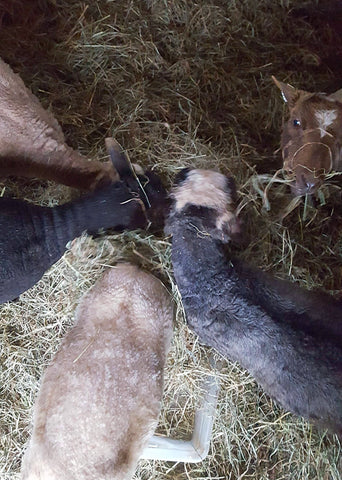
What I’ve learned about grain feeders is that they have to be at shoulder-height; otherwise, my sheep choke. After getting through lambing, Moon nearly choked to death eating grain. I was cleaning out her stall and since I didn’t have a fence to hook the feeder on, I set it on the ground. She literally inhaled the grain, and choked violently for over a minute, before finally vomiting and clearing out her windpipe.***** I use a long goat mineral feeder with partitions that prevent the sheep from eating too quickly, and make it a little harder for them to ram each other. For Roobie and Phoebe, my slower eaters, I feed them in a separate area behind the gate. These feeders hook over the fence gates, and I store them in the greenhouse so they don’t fill with rainwater. I can’t leave the grain feeders attached to a wall in the shed because the sheep will bash one another against it and, invariably, poop in it. The sheep always need free access to loose minerals, so I did screw mineral feeders into the walls. Yes, they get pooped into, but it’s easy enough to scoop out.
Feeding: The pasture is probably the most important consideration when it comes to raising healthy sheep, even more than shelter. It’s something that I’m working on learning more about. Conducting a soil test is perennially on my to-do list. It means walking around the fields and digging 12 holes for dirt samples, mixing up the samples in a sterile container, and mailing it to my extension service. The results will tell me what minerals I’m lacking, and how to amend it. The sheep have grass and forage like wild roses, birdsfoot trefoil, clover, and yarrow, and I give seasonal treats: pine tree, apple tree, and maple tree branches, and pumpkins.
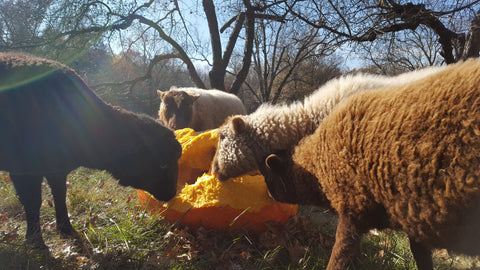
The amount of grain that people tell me they feed their sheep varies from none at all to 1 lb/day. I give the weaned lambs about a cup each, and it goes down to ½ cup when they’re a year old. I’ll give a little more just after they’re sheared, and lure them with a handful of grain when people come to visit. What makes it difficult to decide what and how much to feed my sheep is the lack of clinical data. All of the research on sheep nutrition I’ve come across focuses on how to fatten them as quickly and cheaply as possible for the meat market. Any information I have on nutrition as it affects a sheep’s long-term health is gleaned from talking to other farmers. So I check their condition regularly: feel for their hip bones and ribs, and make sure they’re not too fat and not too bony.
My sheep get loose minerals, which I buy from a farm vet in PA, or from my local feed store. I also give them kelp minerals, but even I think it might be unnecessary. The Shetland sheep on the Shetland Islands give all indication of enjoying the seaweed on those picturesque windswept shores, but I think it could be that there’s precious little else TO eat. On the other hand, kelp does have wonderful phytonutrients and minerals, so why not? The seasonal treats that my sheep get are said to have natural anthelmintic properties: the tannins from the leaves and bark of tree branches, and pumpkin seeds. I don’t rely on these treats as my only dewormer; I dose with chemical dewormers as necessary.
Routine: My routine changes with the seasons, and lambing threw not a wrench, but more of a chainsaw, into my routine. Before lambing, my morning routine was especially easy, since my husband took care of it. At 7 a.m., his morning duties comprised refreshing their water buckets, giving them more hay, and letting them out into whichever field they were using at the time.
Sometime during the day, I check on everyone, especially on very hot days, in case the water buckets have been kicked over/pooped in, and do a quick scan to make sure everyone looks happy. I do my evening chores just before sunset. I scrub and refill water buckets, check the mineral feeders, take out more hay, and feed a little grain. I make sure everyone looks okay, is eating and burping happily, and securely where they should be. And that’s all I do on a daily basis.
Every week, I check the inner membrane of their eyes to see if their worm count is high. I don’t have to check so frequently, but I do it so that the sheep are used to me pulling at the skin around their eyes. I don’t scoop their poop daily, but when I see some soft poop, I will scoop that. I try to scoop up deer poop when I see it, because deer carry a parasite that can cause paralysis in sheep. It’s not my favorite chore, but it’s an easy way to reduce the wormload in the pasture. Spending time scooping poop gives me a chance to watch the sheep, figure out who has the soft poop, and make sure that it gets better after I dose with dewormer. I posted a link below of the scooper I use because it was actually difficult to find one with the tines close enough together to pick up my sheep’s poop (not to get too detailed, but it only worked after the sheep reached 8 months or so and their poop became big enough to not fall through the tines).
Throughout the spring and summer, I walk the field periodically, noting what sort of forage is growing. I try to pull up the poisonous plants I see, like milkweed and bittersweet nightshade. I also pull up prickly plants like thistles and cypress seedlings, because they can cause abscesses in the sheep’s mouths. In the summer, I apply a chemical bug repellent on the backs of their necks, and an all-natural repellent cream on their legs, ears, and tails. To cut down on flies, and therefore the risk of flystrike, I buy fly predators, which are stingless wasps that lay eggs in fly larvae. They apparently only live for a month, so they come in monthly shipments.
The shed is mucked out in the spring and only occasionally through the summer and fall. When I do it, it takes me a week because I can only do a little bit each day. My husband can do it in a weekend, and a contractor did it once in 2 hours. The old hay is pitchforked into my garden cart and dumped in the woods nearby. In the spring and summer, I sprinkle the bedding (hay that falls out of the racks) and even the mucky corral area with Sweet PDZ to neutralize the ammonia. I also sprinkle diatomaceous earth in the bedding, and my reasoning is pretty much the same as my reasoning for giving kelp minerals: there’s no evidence because there’s no research, but it could be beneficial and definitely doesn’t hurt.
My sheep are sheared twice a year, and she vaccinates them, gives them a dose of dewormer, and trims their hooves. I can deworm on my own, but I struggle with vaccinating and trimming hooves. I haven’t spent enough time working on halter-training my sheep, or getting them used to being handled for care. They’re perfectly happy to be scratched and burped, but they have strong opinions about being flipped onto their butts or restrained for me to trim their hooves. But lambing was as gory and mucky as I feared, and I seem to have gotten through it. I think I'm ready to take on some hooves this summer.
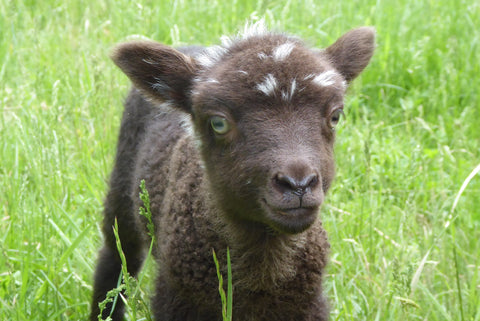
After the buildings and fencing, vet bills are my biggest expense. Right now, I see the vet visits as continuing education for me. I hope to be able to do some of the medical care myself one day, saving the vet for true emergencies. The problem so far has been not knowing what was an emergency and what wasn't.
Here’s a list of some of my expenses, at least the items that come to mind. In the beginning I felt like I was spending about $160 at Tractor Supply every other month on various tools and supplies (hardware cloth and gear ties were new discoveries, and I used them everywhere). I left out all the additional lambing expenses like the barn, portable stall panels, and other supplies.
Fencing & gates (materials and labor): $4000
Run-in shed: $2500
Stall mats: $45 (x2)
Nest wifi camera: $250
Hay racks: $60 (x 4)
Water buckets, grain feeders, mineral feeders
Poop scoop: $15
Sweet PDZ Stall Freshener, 25 lbs: $10
D.E., 4 lbs: $10
Minerals, 25 lbs: $40
Kelp minerals, 50 lbs: $80
Sweet grain, 25 lbs: $25
Hay: $7/bale, delivered and stacked (I figure on 2 bales/week for 6 sheep, for 30 weeks)
Dewormer: $15 (x4)
C.D/T vaccinations: $10 (x2)
Fly predators: $130 (for 4 months)
Shearing: $20/sheep (x2)
Vet visits: $300/visit
Keep in mind that I've only had my sheep for 2 years. When I started, I really thought that with enough research, and if I bought the right things, I could be prepared for everything. What I've learned is that raising sheep is actually the only way to learn how to raise sheep.
Have further questions? Ask me below, and I'll point you to a resource. If you already have sheep, I'm sure you have lots of opinions on everything I wrote! Please don't hesitate to let me know if you see something egregiously wrong.
*In the case of my sheep, I’ve come to learn that grimacing, stretching their heads up like they’re in pain, and then burping is, actually, how they express their affection for me. They burp up their cud and chew it at the leisure when they feel relaxed, secure, and comfortable.
**Ok, it’s probably the snake that surely lives in the hay storage that keeps it mouse-free, but I try not to dwell on that.
***Not being particularly long-legged, me climbing over the panels is exactly the circus act you're imagining.
****I know I say that casually, but it was a real accomplishment for me, and it involved a lot of Google searches along the lines of, “how to drill a hole where you actually made the pencil mark,” and “how to adjust holes that are ⅛” too far apart.”
*****See? There’s your requisite “another way a sheep can possibly die” tidbit for the day.
Resources
Books:
The Fleece and Fiber Sourcebook, Deb Robson
The Sheep Book, Ron Parker
The Sheep Raiser's Manual, William Kruesi
Storey's Guide to Raising Sheep, Paula Simmons
Websites:
Maryland Small Ruminant Page
Sheep 101
Sheep FAQ, Maple Ridge Sheep Farm
Flock Health, Canadian Sheep Raising Federation
Parasites, Canadian Sheep Raising Federation
Equipment & Supplies:
Premier 1
Maryland Sheepman

Comments on post (5)
Ricky says:
Excellent post!
engetly says:
canadian pharmacy cialis 20mg[/url]
Mixnouts says:
https://booksfactorypdf.weebly.com/uploads/1/3/4/6/134635235/rx-free-methods-2021.pdf
KW:
Do ROBLOX Gift Cards Get You Builder’s Club 2021
ROBLOX Robux 2020 DECEMBER UPDATED
How To Get ROBLOX Gift Cards In India 2021
Robux Generator No Verification 2020 DECEMBER UPDATED
Tara Smith says:
Thanks for this very informative post. I’m looking forward to the arrival of my first flock this summer, and learned so much from you. I had no idea that deer poop causes paralysis in sheep – Our pastures see many deer, so I’ll have to pay special attention to this chore. Also, where do you purchase the fly predator wasps from?
Heathet says:
What a lovely read. You seem to be a very caring sheep owner. You have a lot of knowledgeable advice for only 2 years experience beibg a sheep owner/farmer. Thank you for all the helpful insights. I would love to read more, particularly on lambing and the breeding. Also on how practical it is to farm sheep for the wool and how that process works. Thanks again.
Leave a comment